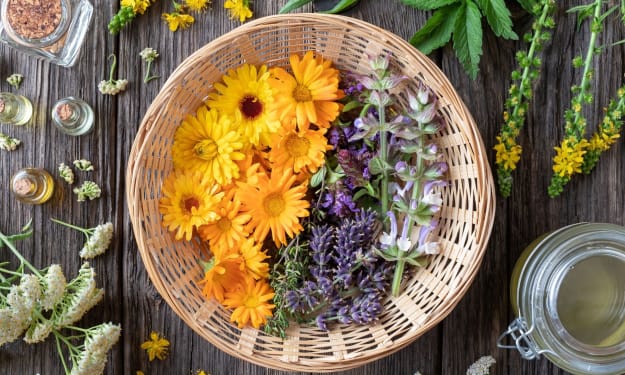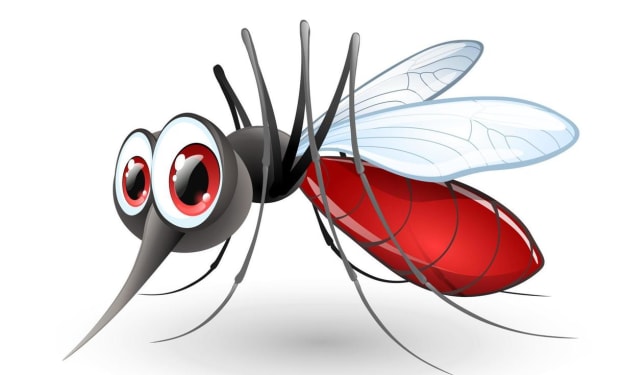10 Painkilling Plants You Can Grow Right At Home
And why you should do it.

Herbs and essential oils have long been the preferred painkillers in traditional medicine. For alleviation, they used them topically or ingested them. Herbs are just as effective at treating a range of physical and mental health problems as manufactured medications. However, keep in mind that some of them might also result in adverse reactions and drug interactions.
The Top 10 Pain Relieving Plants
Analgesic or painkiller herbs are used to treat both acute and chronic pain. To lessen pain signals, their actions are focused on the neurological system, or brain. Some herbs can help you fall asleep because they fight the chemicals that cause pain. An analgesic dulls the pain, but unlike anesthetics, it does not take away the sensations.
There are numerous plants that have analgesic properties, and the good news is that you can grow many of these plants in your own backyard. The majority of them are lovely ornamentals with medicinal benefits.
Here are some of the plants you can use in place of over-the-counter painkillers:
Turmeric
Curcuma longa, also known as turmeric, is a powerful analgesic and pain reliever. It is particularly prized for its ability to reduce systemic or localized inflammation. Turmeric has chemicals that lessen oxidation, inflammation, and pain. Osteoarthritis and other types of joint and muscular pain can benefit from it.
The tropical plant turmeric thrives in soil that is loose, rich in organic matter, and has a pH between 5.5 and 6.5. Give each tuber enough room to grow (approximately 8 inches apart) so the roots can expand and develop into strong plants. Raised beds, grow bags, and containers all work well for growing turmeric. The ideal soil depth is at least 12 inches.
Ginger and cayenne, which are both analgesic spices, go well with turmeric to increase its potency. Simply combine 3 tablespoons each of cayenne, ginger, and turmeric powder. To relieve discomfort, thoroughly combine them and take 1/2 teaspoon of the resulting concoction in warm water.
Ginger
The rhizome of ginger (Zingiber officinale) is another plant with potent analgesic qualities. It may be grown indoors or in the garden, and it can be used in a wide range of cuisines and for medical purposes. Salicylates found in ginger are converted to salicylic acid, which reduces nerve discomfort. It is a well-known treatment for respiratory problems and is quite effective at lowering pain and inflammation.
Ginger can be grown by cutting fresh ginger root into pieces and letting them dry for one or two days. Put them in containers or in the garden with compost and well-draining soil. Keep the ginger somewhere warm and sunny, but out of direct sunlight. Keep the soil wet but not saturated by watering it. When the stems and leaves of the ginger begin to yellow, it is time to harvest it. Bring the pots inside in colder climates before they freeze.
Simply boil a thumb-sized root in water and drink the concoction once a day to treat discomfort.
Lemongrass
Lemongrass (Cymbopogon citratus), an herb with a lemony smell, gives many Asian foods a distinct zing. This plant can be grown successfully in a wide range of soils and environments, though it does best in warm, humid environments. Although it is sensitive to frost, it might grow well indoors. Lemongrass affects the central nervous system and acts as a sedative. It works wonders for intestinal stress and inflammatory discomfort.
The easiest way to grow lemongrass is in a container, so you can keep it outside in the summer and bring it inside for the winter. Cut the stems back to 10 cm when the foliage starts to turn brown. Once springtime growth starts, fertilize once a week with a liquid fertilizer.
To calm the nerves, lemongrass's fresh leaves and stalk can be soaked in tea or another hot beverage.
Cayenne
Cayenne pepper, or capsaicin (Syzygium aromaticum), is a potent topical painkiller that works by reducing the amount of substances that carry pain signals to the brain. There is no other natural cure more effective than cayenne for painful diseases. Its medical analgesic activity blocks the perception of pain and lessens any inflammation. Additionally, it helps to lessen nerve injury, surgery, and osteoarthritis-related joint discomfort.
You can manufacture topical cayenne directly from the plant blooming in your garden by following this simple recipe:
Dehydrate and dry cayenne peppers.
Once they are completely dried, crush them into a fine powder in the food processor.
2 tbsp. of the dried cayenne pepper and 1/2 cup warm coconut oil are combined to create a smooth gel.
For 20 minutes, apply the gel to the sore area.
Cayenne tea
Photo by
Richelleg/canva
Marigold
A summer garden looks lovely with the marigold's (Tagetes erecta) golden bloom. The same flowers have strong anti-inflammatory and pain properties. Xanthophyll, which is found in marigold, has potent analgesic effects.
The simplest technique to treat a wound or blister is to crush a marigold flower and apply it to the affected area. Another method for treating painful menstruation and infrequent menses is to use fresh marigold petals soaked in water.
Horseradish
One of the easiest plants to raise for vegetables and medication is horseradish (Armoracia rustica). Its root parts can be purchased in various supermarkets and grown right away in the garden or in containers. Horseradish's strong roots can add flavor to a variety of foods. Additionally, it helps to relieve the symptoms of the flu and the cold, as well as arthritis and abscess pain.
Horseradish is easy to grow from young potted plants or from long segments of root (thongs). These ought to be sown in the spring or at the beginning of the summer, ideally in a sizable container, in full sun or part shade. In a tiny raised bed or other similarly contained area, they can also be planted.
Its root and bark are used to make a toothache remedy. Simply swish and gargle it three times a day or as needed to relieve the discomfort of an inflamed tooth.
Feverfew
A well-known antipyretic (which lowers fever) and antiphlogistic (which lessens inflammation) is feverfew (Tanacetum parthenium). The plant is so powerful that it cannot be used in conjunction with an analgesic drug. Feverfew is a highly efficient all-around pain reliever for different forms of pain.
Feverfew was used in the days before anesthesia to help women through birthing discomfort. Women also used it to alleviate menstrual-related issues, including cramps and pain. Take feverfew tincture for quick relief if you suffer from toothaches, migraines, stomachaches, skin conditions, or ear pain.
An easy-to-grow medicinal herb is feverfew. It thrives in full sun or partial shade, well-drained soil, and both.
For various herbal painkillers, use the following general recipe:
Vodka with a proof of one hundred
One liter of alcohol requires 200 grams of dry plant.
Steps
Insert the herb in a clay or glass pot.
Directly into the container with the plant, pour the alcohol to cover it.
Place the container somewhere cool and dry after sealing it.
For 21 days, shake the container frequently.
The alcohol should be strained and kept in a dry place for many years.
To use:
Use a dropper or a tiny syringe to distribute the tincture under the tongue. Before swallowing the beverage, keep it in your mouth for a short while. One time per day, take no more than two tiny droppers of the tincture. Children should not use tinctures because they contain alcohol; instead, use non-alcoholic menstruums such as apple cider vinegar or vegetable glycerin.
Rosemary
Rosemary (Rosmarinus officinalis) can grow anywhere and is tolerant of a wide range of climatic conditions. It is mostly prized as an aromatic herb that gives dishes a distinct aroma and flavor. In traditional medicine, rosemary is mostly utilized as a brain tonic to improve memory and combat depression. In order to treat migraine, rheumatic pain, and dysmenorrhea, it also functions as a mild analgesic and antispasmodic.
Since rosemary is a woody herb, cuttings work better than seeds for growing it. It thrives in a sunny area with well-draining soil.
Fresh rosemary tea is effective in treating sciatica, back pain, exhaustion, headaches, and other joint and muscular discomfort. Use rosemary oil to massage hurting body parts, and drink rosemary tea twice a day to relieve pain.
Lavender
Plant the potent and fragrant lavender (Lavandula agustifolia) in your yard to benefit from its relaxing effects and aesthetically pleasing presentation. The neurological system is slowed down, and pain perception is suppressed quite well by lavender. Without sedating, this scented tonic herb can reduce anxiety. Without falling asleep, you can still feel its peaceful and relaxing benefits.
Lavender is not only fragrant and has lovely blossoms, but it also has healing properties for cuts and skin inflammations. It works well for joint and muscular issues brought on by arthritis and rheumatism.
The Mediterranean herb lavender grows best in hot, sunny climates. It thrives in full sun, warm soil, and good drainage.
Pick a few lavender flowers and make this calming tea if you are struggling with pain. One cup of boiling water should be added to a mug along with a few lavender buds. Drink it after letting it steep for a short while to ease muscle pain and spasms. To enjoy the relaxing benefits of lavender tea, drink a cup of it daily for two weeks.
Thyme
A variety of meals use the herb thyme (Thymus vulgaris), which imparts an earthy flavor to food. The capacity of this evergreen plant to improve food stability and decrease oxidation makes it useful as a food preservative.
Thymol and carvacrol, two of the natural chemicals found in thyme, are also ostensibly potent analgesics. It can lengthen the effects of diazepam and boost the analgesic properties of paracetamol.
The Mediterranean herb thyme grows best in hot, sunny climates. It thrives in full sunlight and well-drained soil.
The best way to use thyme for pain relief is as a decoction. Take a cotton cloth, stuff it with freshly crushed thyme leaves, and lay it on the affected area if you have a persistent headache. Deep wounds and neuralgia can be treated with the poultice. Before applying the poultice to open wounds, clean the area with thyme decoction.
Takeaway
In the apothecary of nature, herbs serve as our natural medicine. They served as the basis for many synthetic pharmaceuticals for thousands of years before the discovery of conventional medicines. However, use caution if you combine these medications with alternative therapies since they could increase or decrease their effectiveness.
Attributions:
Top 12 natural painkillers: Herbs and other remedies. (n.d.). Top 12 Natural Painkillers: Herbs and Other Remedies. https://www.medicalnewstoday.com/articles/324572
Marwick, C. (n.d.). Researchers investigate potential use of plant as a pain killer. PubMed Central (PMC). https://doi.org/10.1136/bmj.331.7525.1104-c
5 Surprising Natural Painkillers: Boswellia, Turmeric, and More. (n.d.). 5 Surprising Natural Painkillers: Boswellia, Turmeric, and More. https://www.healthline.com/health/pain-relief/surprising-natural-pain-killers
About the Creator
Richelle Gerner, Rootbound Homestead
Rootbound Homestead is a community bound by roots. Leaving our old comfy life in FL to move to NY to start living cleaner, more simply, and with purpose. Garden hacks, tips and tricks, natural medicine, healing, animals, recipes and more!






Comments
There are no comments for this story
Be the first to respond and start the conversation.